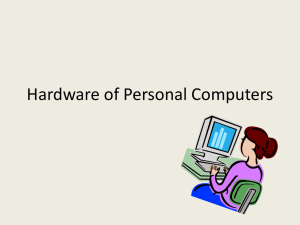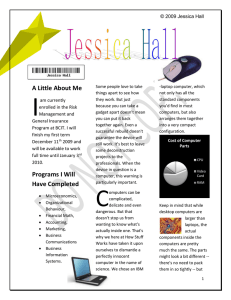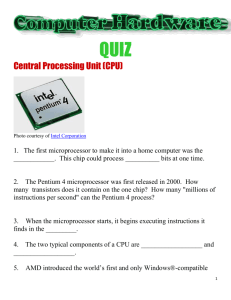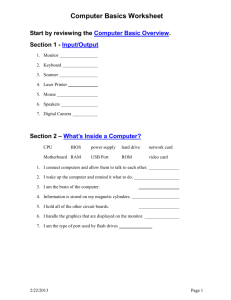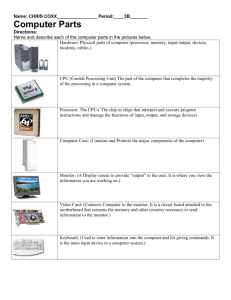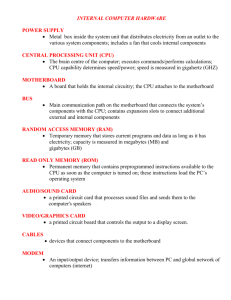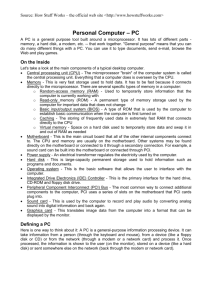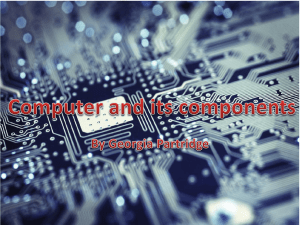Hardware of Personal Computers
advertisement
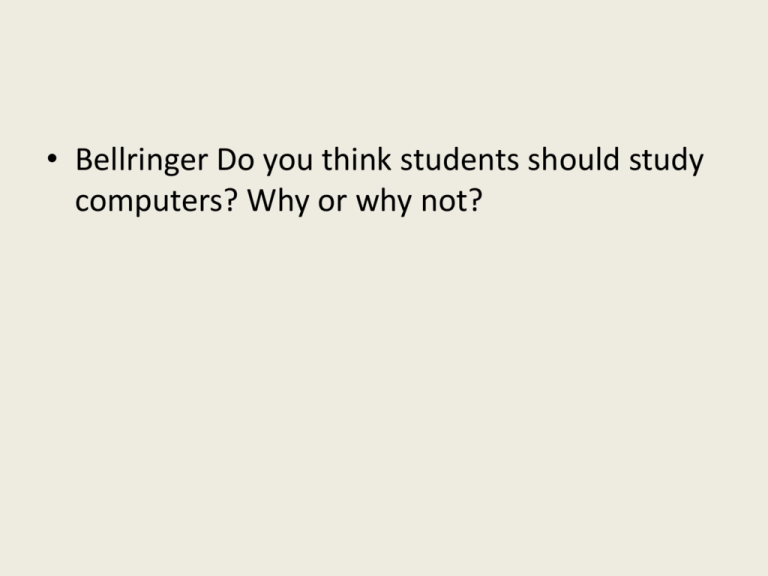
• Bellringer Do you think students should study computers? Why or why not? What is a Computer? • A computer is an electronic device that accepts information and instructions from the user, processes data, and display the data. What are Basic Hardware of a Personal Computer? What is a Hardware? • Hardware is any part of the computer system that is tangible. It works with the software to process data. Computer Case • Contains the major components of the computer. It helps protect them. Monitor • A display screen to provide “output” to the user. • Function: view the information your are working on Motherboard • The motherboard is a circuit board that is the foundation of a computer • Function: allows the CPU, RAM, and all other computer hardware components to function with each other Processor • The CPU – The chip or chips that interprets and executes program instructions and manage the functions of input, output, and storage devices. RAM • Random Access Memory RAM is a computer’s temporary memory, which exists as chips on the motherboard near the CPU. • Function: stores data or programs while they are being used and requires power. Modem • The place where the computer is connected to the phone line. Network Card • A circuit board that connects the computer to the rest of the network usually using special cables. Video Card • Connects the computer to the monitor. It is a circuit board attached to the motherboard • Function: contains the memory and other circuitry necessary to send information to the monitor for display on screen. Sound Card • Connects the speakers and microphone to the computer. CD Rom Drive • The drive that plays CDs and reads data that has been stored on the CD. Floppy Disk Drive • A device that holds a removable floppy disk when in use; read/write heads read and write data to the diskette. Hard Disk • Magnetic storage device in the computer. Keyboard • Used to enter information into the computer and for giving commands. Mouse • An input device operated by rolling its ball across a flat surface. • Function: used to control the on-screen pointer by pointing and clicking, double-clicking, or dragging objects on the screen. Information Processing Cycle 1 2 4 Input Devices Processing Unit Output Devices Storage Devices 3 Information Processing Cycle • All computers follow the same basic operations: (1) input, (2) processing, (3) storage, and (4) output. What is an Input Device? • whatever is "put into" the computer to make it function • Examples: keyboard, microphone, mouse What is a Processing Unit? • manipulating whatever data has been input to transform it to information • Everything in the tower, motherboard, CPU What is a Storage Device? • A place where you can keep processed data. • Examples: USB, Floppy disc, CD What is an Output Device? • resulting from processing inputs which is useable by humans • Examples: monitor, speakers, printer Classification of Hardware 1 2 4 Input Devices Processing Unit Output Devices Storage Devices 3 RAM • Random Access Memory • Represent primary storage or temporary storage • Hold data before processing and information after processing, before being sent to an output or storage device • Can be read and written to • Volatile- the contents are lost when the power goes off or is turned off ROM • Read only memory • Cannot be written on or erased by the computer user without special equipment • Contain fixed start-up instructions • Contain instructions on start up • Non volatile • Bellringer: List the steps in the Information Processing Cycle and give one example for each. Try not to use your notes! This is review. • Pick up the worksheet on the table and complete it on your own time. You may use your notes if necessary. To Do: • Schedule: – Application Software examples – Review (Wednesday) – TEST (Professionalism and Parts of a Computer) • Thursday What is Software? • Software- all the electronic instructions that tell the computer how to perform a task • Application software helps the user perform specific tasks – Word processing, presentation, database, electronic spreadsheet • System software helps the computer perform specific tasks – Windows, Mac OS X, Device driver software Application Software • Word Processing – working mainly with text • Spreadsheet – used primarily with numbers & charts • Database – allows for entry of data in an organized manner, used for reporting • Presentation – create presentations using projection devices • Desktop Publishing – used for creative design Microsoft Office Application Software • • • • • Word Processing- Word Spreadsheet- Excel Desktop Publishing- Publisher Database- Access Presentation- PowerPoint System Software • System software are running processes on your computer. They are necessary features in order for your computer to run and do the things that computers are expected to do. For example: boot up, logging in, connect to the internet, etc. Types of Personal Computers • Desktops – may sit on a desk or on the floor (a "tower") – powerful enough to run everyday business and personal applications – have separate hardware components for the computer, monitor, keyboard, and mouse. • Laptops – – – – – notebook computers, have all the functionality of a desktop computer small and portable include a display, keyboard, and trackpad integrated into a single piece of hardware Some laptops, called tablet PCs, recognize handwriting and allow you to work with a pen-like stylus • Netbooks – – – – – ("Inter net note books) less powerful than traditional laptops, but as they are generally used only for Internet-related activities such as e-mail and surfing the Web do not need as much memory, processing power, or storage space smaller, lighter, and less expensive than fully-functional laptops. • Personal Digital Assistants (PDAs) – – – – handheld computers, PDAs fit in the palm of your hand. While less powerful than a desktop or laptop computer, a PDA includes key productivity functionality like maintaining a calendar, address book and a to-do list – have Internet connectivity so you can send and receive email and surf the Web • SmartPhones – combines the functionality of a PDA with a cellular telephone – often include photo and video capabilities
